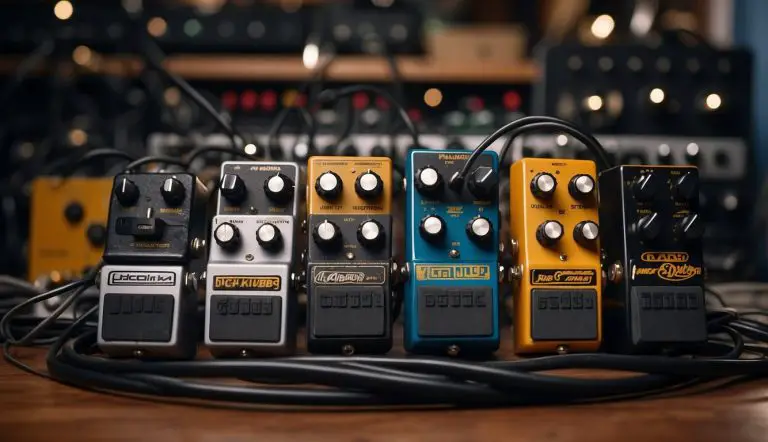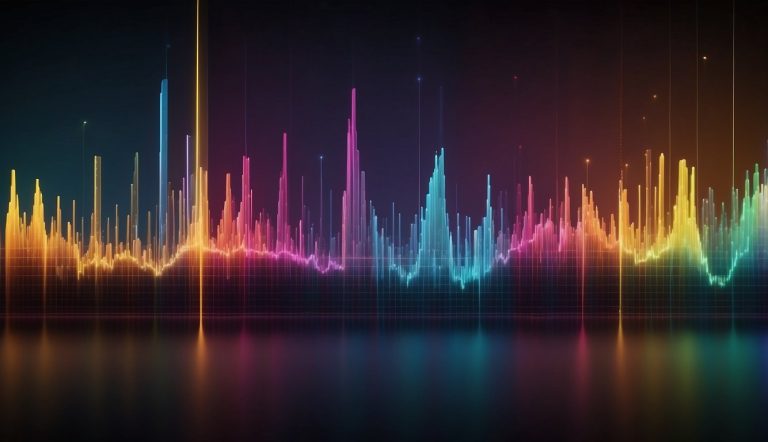Why Guitar Pedals Don’t Come with Power Supply: Unboxing the Mystery
When I started playing electric guitar, one of the first accessories I purchased was a guitar pedal. To my surprise, I discovered it didn’t come with a power supply. This is actually a common practice within the industry.
The main reason is cost efficiency. Excluding the power adapter keeps the pedal’s price lower, which can be appealing to guitarists just starting to build their pedal collection.
Another reason is the assumption that many players will integrate these pedals into a larger pedalboard setup.
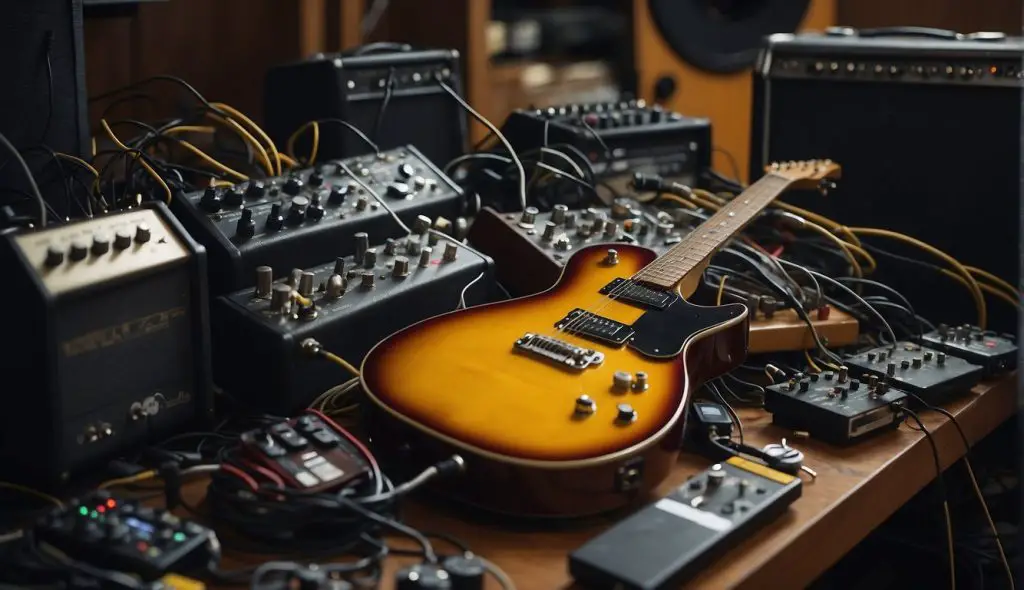
Guitarists quickly learn that different pedals require different power requirements. Providing a one-size-fits-all power supply can be challenging when pedals differ significantly in voltage and current draw. This variability means that it is more practical for players to purchase a power supply suitable for their specific setup requirements.
Additionally, many players appreciate the flexibility to choose a power supply that matches their performance needs, especially when noise-free operation is critical.
Key Points
- Guitar pedals often don’t include a power supply as a way to reduce costs.
- A uniform power supply isn’t feasible due to varying voltage and current needs of different pedals.
- Guitarists usually prefer to select a power supply that suits their specific pedalboard configurations.
Table of Contents
Power Supply Essentials – Breaking Down The Basics
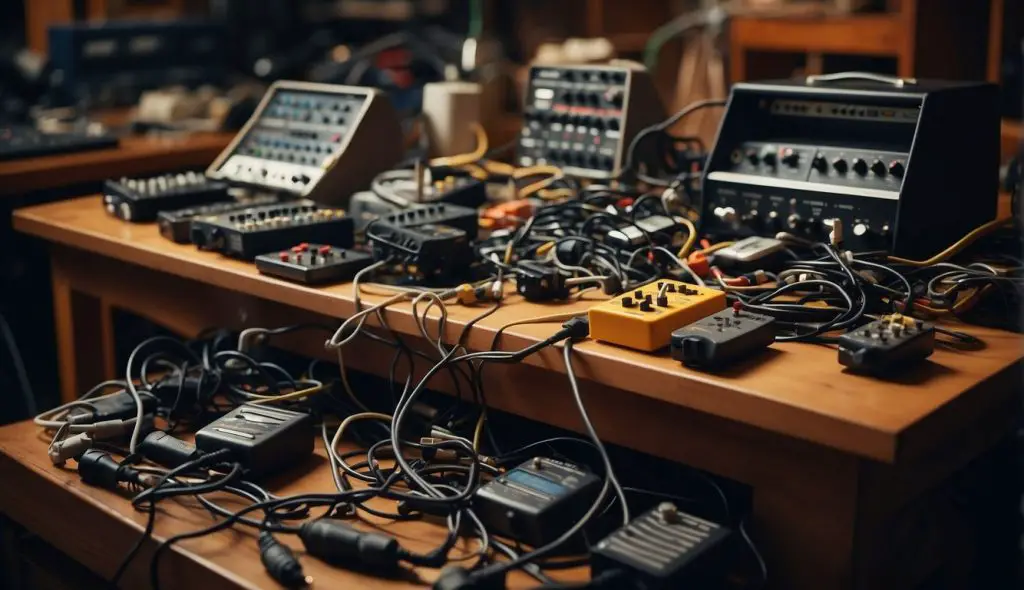
In ensuring our guitar pedals operate smoothly, it’s crucial for me to be familiar with their power supply specifics.
Here’s a straightforward breakdown of the terminology and compatibility requirements.
Essential Power Terminology
When discussing power supplies, we often come across terms such as voltage, current, power, amps, and milliamps. Let’s demystify these:
- Voltage (V): This is the pressure from the power source that pushes electricity through a circuit. For guitar pedals, common voltages include 9-volt, 12-volt, 18-volt, and sometimes 24-volt.
- Current (I): Measured in amps (A) or milliamps (mA), this refers to the flow rate of electricity. Pedals typically require a few hundred milliamps to operate.
- Power (P): This is the rate of energy used, calculated as voltage multiplied by current (P = V x I). It’s expressed in watts (W).
Compatibility and Requirements
Each pedal has specific power requirements to function correctly. Paying attention to these ensures I don’t damage the pedal or affect its performance.
- Voltage Compatibility: Using the correct voltage is vital — a 9-volt pedal won’t function properly with an 18-volt supply and vice versa.
- Amperage Requirements: The pedal will only draw the current it needs, but my power supply should be able to deliver at least that much. If the pedal needs 100 mA, make sure the supply can provide at least that amount of current.
Understanding these essentials helps me select a power source that ensures my pedals perform as expected, without any unpleasant surprises.
Common Reasons for Excluding Power Supply
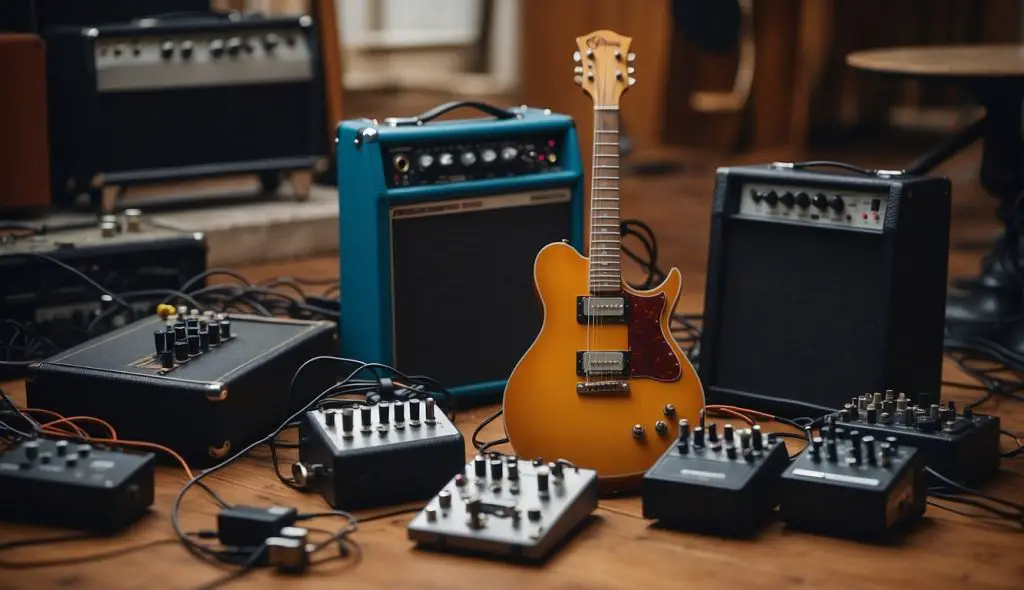
When we talk about guitar pedals, I’ve noticed that a recurring question from fellow guitarists is why they often don’t come with a power supply. Let me pinpoint major factors, including cost and user preferences that come into play.
Cost Considerations
If pedals included power supplies, the cost of each pedal would certainly rise. Manufacturers need to keep pedals affordable, and here’s how excluding a power supply helps:
- Manufacturing Cost: Save costs on production, as power units for each pedal are not cheap to make.
- Shipping Cost: Lessen the weight and size of the packaging, cutting down on shipping fees.
It’s a balance: lower upfront costs for guitarists versus the need to buy a separate power supply could be seen as a con. However, many guitarists already possess a power source — like a pedalboard — making the inclusion redundant.
User Preferences and Flexibility
From my experience, flexibility is a huge factor. Compatibility and logistics play significant roles; let me break it down:
- Power Requirements: Pedals can have varying power requirements— voltage, current, polarity — and guitarists prefer using power supplies that match their specific needs.
- Pedalboards: Many use pedalboards with integrated power supplies, providing a one-stop power solution that’s customizable.
In essence, leaving out power supplies lets guitarists tailor their setups, fitting into a range of pedalboard configurations — a definite pro for versatility.
Technical Insights
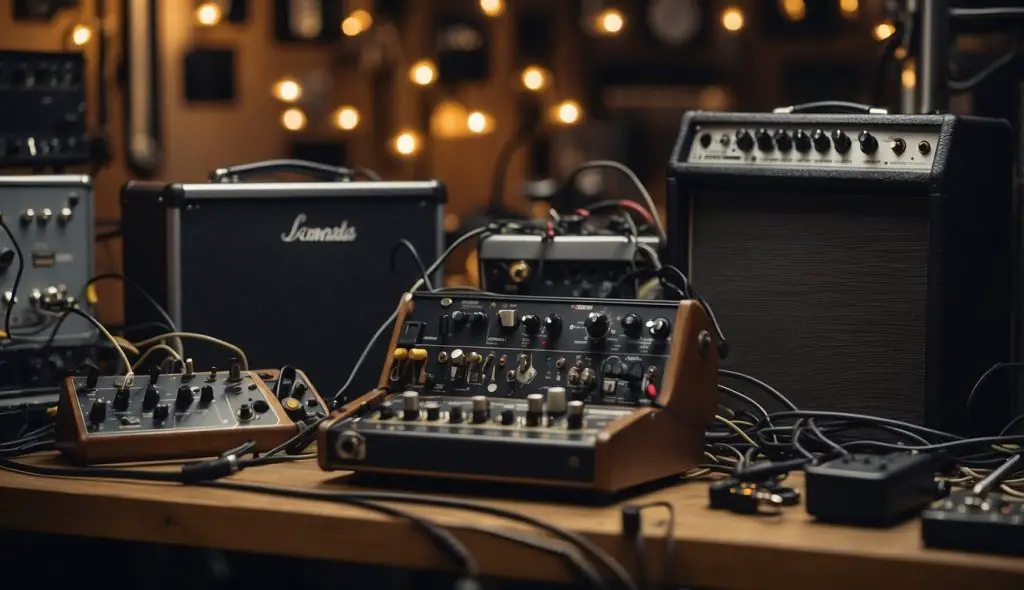
When exploring why guitar pedals often don’t come with a power supply, I quickly learned how crucial power considerations are to the pedal’s performance. Let’s examine the specifics.
Dealing with Noise and Interference
Noise and hum can be a guitarist’s nightmare, often caused by electrical interference or ground loops. I found that ground loops occur when multiple devices are connected to a common ground through different paths, which can result in a loop that picks up interference. This turning into a frustrating hum through an amp. To mitigate this, isolated connections – where each pedal is connected to its own separate ground source – are paramount.
I use an isolated power supply, which can drastically reduce the chance of such unwanted noise.
The Role of Isolated Power
An isolated power supply provides individual power sources for each pedal, isolating them from each other. Why is this important?
Well, when power supplies are not isolated, they can introduce noise to the signal chain, as one noisy pedal could affect all the others. Using isolated power helps me maintain the integrity of my guitar’s signal by ensuring that each pedal gets a clean and separate supply.
This is essential when I want my effects to sound crisp and clear without any unwanted noise.
Impact of Power on Signal Quality
Power doesn’t just make my pedals work, it shapes the quality of the signal that passes through them.
Insufficient power can lead to a weakened signal, and a weak signal is susceptible to degradation, noise, and interference. That’s why choosing the right battery or power supply can make all the difference.
My tip is always to check each pedal’s power requirements and provide what’s needed. An isolated power supply can ensure that each pedal is getting the exact amount of power it needs without affecting others in the chain, resulting in a cleaner and more consistent signal quality.
Selecting the Right Power Accessories
When it comes to powering my pedalboard, I’ve found that having the right power accessories is crucial for a reliable and noise-free performance. It’s about understanding the power requirements and maintaining safe connections.
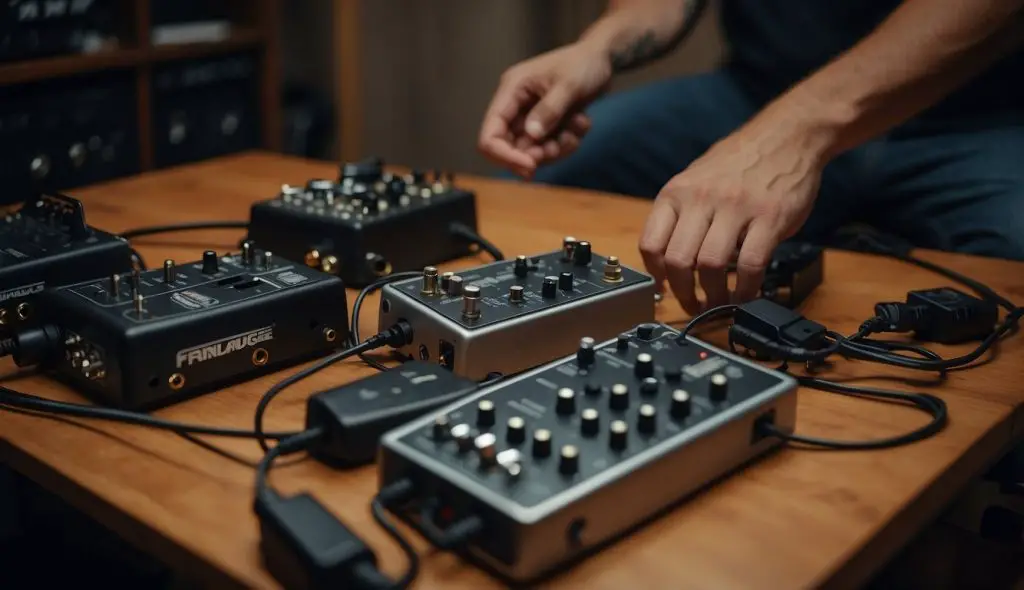
Exploring Power Options for Pedalboards
For my pedalboard, a variety of power options are available, each with its own benefits. I first look at power adapters, which are individual units designed to supply power to a single pedal. They’re straightforward but can crowd my power strips.
Alternatively, I consider isolated power supplies. These units offer multiple outputs, ensuring each of my pedals receives clean, isolated power, which greatly reduces noise.
For a compact setup, I might use a daisy-chain cable, which allows me to power several pedals from one power source. However, I make sure to check each pedal’s power requirements because overloading a daisy-chain can lead to noise issues or even damage my pedals.
Here’s a quick reference on power connector polarity, which is vital to match correctly to avoid damaging my pedals:
- Positive (+) outer
- Negative (-) center (most common for pedals)
Guidelines for Safe Power Connections
When I’m setting up my pedalboard, safety is my priority. I always ensure that the power source can handle the total current draw of all my pedals combined. This prevents any potential overloads or electrical mishaps.
I also double-check that the polarities match, as connecting a pedal with reverse polarity can cause irreparable harm to the pedal.
For troubleshooting, if I encounter any noise or performance issues, my first step is to check all connections. Loose cables or incorrect power matching might be the culprits.
If I’m daisy-chaining pedals, I’m aware that this can sometimes introduce noise, so I try isolating pedals to see if that clears up the sound.
Here’s a simple table I use to make sure I’m connecting everything properly:
| Item | Specification | Check |
|---|---|---|
| Power Adapter | Voltage (V) and Current (mA) | Match with pedal requirements |
| Daisy-chain | Total current draw | Should be under the power source’s max current |
| Connector | Polarity (+/-) | Must match pedal’s requirement |
| Isolated Power Supply | Output isolation | Ensure each output is indeed isolated |
Frequently Asked Questions
I often hear concerns and inquiries about why guitar pedals typically arrive without a power supply.
Let’s answer those questions based on what I know to help clarify any confusion.
What are the reasons manufacturers do not include a power supply with guitar pedals?
Manufacturers may not include a power supply with guitar pedals to keep costs down for themselves and consumers. Many guitarists already have power supplies or prefer to choose their own to suit their specific rigs.
Is there a universal power supply that can be used with all types of guitar pedals?
There is no true universal power supply, as pedals can vary in voltage and current requirements. However, there are multi-output power supplies designed to accommodate multiple types of pedals on a single board.
How can I power my guitar pedals if they don’t come with their own power source?
Pedals without a dedicated power source can be powered using individual power adapters, a multi-output power supply, or batteries. If the pedal has a battery compartment, you can also use batteries.
Are there any advantages to buying a separate power supply for my pedalboard?
Buying a separate power supply allows for a customized power setup. This can reduce noise in the signal chain and provide the correct power needs for each pedal, potentially improving their overall performance.
What should I look for when purchasing a compatible power supply for my pedals?
When purchasing a power supply, check that it matches the power requirements of your pedals. This includes voltage, current, and polarity. A supply with isolated outputs can also prevent noise and interference.
Can daisy chaining power supplies affect the performance of guitar pedals?
Daisy chaining, or using a single power supply to power multiple pedals, can introduce noise and hum. This is especially true if pedals have different power requirements. Isolated power supplies are more advisable for optimal performance.



